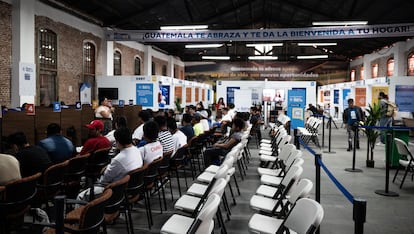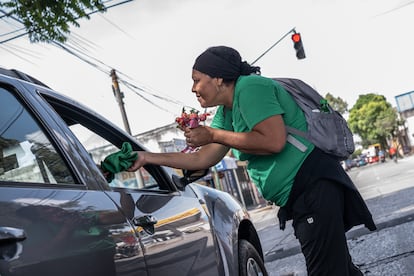“I never imagined migrating in reverse”: Deportees from the United States and forced returnees on the new route south

It's 10:30 a.m. on a Thursday in July in Guatemala City. A charter flight from Eastern Air Express, the airline contracted by U.S. Immigration and Customs Enforcement (ICE) since February to operate deportation flights from Guatemala , lands on the Guatemalan Air Force runway.
Within minutes, the doors open and a silent line of about 50 people, escorted by staff from the Guatemalan Migration Institute, set foot in their homeland. Some are still wearing the gray jumpsuit and blue slippers, the uniform of detention centers for undocumented persons.
Among them walks Olinda, 31, originally from the north of the country. With one hand she pulls the collar of her sweatshirt to cover her face, in the other she holds a handkerchief soaked with tears. Head bowed, she enters with the others the Returnee Reception Center, where they receive a welcome talk, food, and legal guidance. Here, the staff of the Migration Institute is in charge of reception, immigration control, and then provides job guidance at the new Attention Center for Returned Migrants, inaugurated on June 2 in the historic center, to which most are subsequently transferred. They try to make the forced return a less traumatic experience. But Olinda continues to cry.

She can't forget the four months of detention in Pennsylvania, nor the chains that bound her hands, feet, and waist until the plane entered Guatemalan airspace. Much less the moment she was ripped from her life while going with her husband to buy materials for the remodeling company where they worked in Maryland. When the police stopped the car for a check, she began to shake. Neither she nor her husband had papers. It was a day in March, and as the car approached the side of the road and she rolled down the window, only one thought crossed her mind: "Will I ever see my daughter again?"
“I never saw her again,” she says. “She was 13 years old and was in school when they caught me. I only spoke to her by phone since my arrest. At first, I asked for her to be deported with me, but I gave up when I realized there are no doctors or decent food in prison. I didn't want my daughter to go through this.”
Olinda sobs and blows her nose. Micaela echoes her, having already taken off her gray jumpsuit and changed back into the clothes she was arrested in. She lived in the United States for 12 years. There, she leaves behind three children: the two youngest are Americans by birthright, enshrined in the 14th Amendment of 1868, which is at risk of being revoked by the Trump administration. “They caught me at home. I don't know how they knew I didn't have papers…” she murmurs. “My children are still there, but I'll die if I don't see them again. I want to bring them, but I have to get organized because they've always lived there, and changing everything for them won't be easy… Life here is very different.” Micaela is 45 years old and has lived a hard life in both countries. She is illiterate and signs with her thumbprint. She is sad because she thinks that without knowing how to read or write, it will be even more difficult to reunite with them.
[My daughter] is 13 years old and was at school when I was arrested. I've only spoken to her by phone since the arrest. At first, I asked to be deported with me, but I gave up. I didn't want my daughter to go through this.
Olinda, Guatemalan deportee
Olinda also plans to bring her daughter, who now lives with a neighbor and hasn't attended school since her arrest. "Because she's a minor, she needs me for all her schoolwork," she says, still crying. "She's like she's stranded without me. I hope to find a job here to pay for her fare, no matter what."
Juan watches this scene and sighs. “They arrested me with 15 other colleagues while we were working,” he says. “The police came in without the boss saying anything. After years there, it was horrible. That guy [Trump] is fucking crazy ,” he blurts out in English, clenching his jaw and touching his forehead as if to reinforce his statement, before trying to find a way to call his family to let them know he's arrived.
Although Secretary of State Marco Rubio spoke in Guatemala in February of a supposed 40% increase in deportations , the truth is that expulsions have decreased significantly. Especially to Guatemala, one of the countries with the most deportees in proportion to its population. Between January and July 16 of this year, 24,139 people have been returned . An average of 103 deportees by air per day, compared to 168 per day in 2024, when the total reached 61,680 . However, the number of flights has not decreased dramatically, although some arrive below the maximum capacity of about 120 seats. There is no official explanation, but it can be assumed that it is a strategy by Trump to pretend a high level of deportations to his electorate. In fact, in June the news broke that the United States had set a new record , with 209 deportation flights, without specifying the number of deportees.
Unlike the previous administration, the majority of those repatriated are no longer migrants detained at the border, but rather people arrested within the country.
In fact, almost no one even manages to cross from Mexico. In May 2025, more than 12,400 people were detained at the southwest U.S. border, compared to more than 170,000 in the same month the previous year. A reduction of more than 92%.
Return and transit to the southGuatemala, a country that has historically been a source of migrants, is increasingly becoming a place of return and transit, now more to the south than to the north. David, a 16-year-old Venezuelan, knows this. He left Colombia with his 50-year-old mother, Marisol, in January 2024, heading for the United States. With a glass cleaner in one hand and disinfectant in the other, he practices washing the windows of a car parked in the historic center. It's his first day doing so, because he normally helps his mother sell candy at traffic lights. A year ago, they did it to finance their trip north. Now they do it to pay for their return south, after eight months living on the streets in Mexico City, waiting for a humanitarian flight that would allow them to "self-deport" to Colombia or Venezuela, but that never came. "We didn't achieve the American dream," Marisol says. "We're depressed, but we couldn't stand being on the streets any longer." Following Trump's inauguration, which canceled the CBP One application for asylum and humanitarian parole , a temporary permit that benefited migrants from Cuba, Venezuela, Nicaragua, and Haiti , thousands of Latin American migrants decided to return to their countries of origin.

Crossing borders back is also a business. “The journey between Panama and Colombia is by raft and costs $300 per person (€256),” says Beti, a 32-year-old Venezuelan. “It’s better than crossing the Darien jungle , but I don’t even know how many candies we’ll have to sell to raise $1,500.” Beti is five months pregnant. She is traveling with her husband, Edwin, 38, and three other children, plus the one on the way. They are returning to Caracas after a year and a half trapped on a round trip that cost them about $30,000. “I never imagined migrating the other way around,” she continues. “The worst thing is that the police and drug traffickers assault us anyway. We’re still merchandise, even though all we want to do now is go back.”
The worst part is that the police and drug dealers still attack us. We're still merchandise, even though we just want to go back.
Beti, Venezuelan migrant
With them is Richard, a 50-year-old Venezuelan, who carries a cane with an iron whip hidden inside. “After what I went through, you have to defend yourself,” he says, smiling nervously. He was deported from the United States to Mexico on March 1 after being detained while working for Uber in Dallas. “They deported me, even though I had a work permit and a driver's license,” he says. “They took me to the detention center, and all I had time to do was call a friend to watch the car.” He then traveled by bus to Panama, but after two months he tried to travel north again. In June, he reached Mexico, where he lived on the streets for three weeks, defending himself each night from drug traffickers and thieves. But when he realized the increased border controls, he decided to give up. “Now I'm going to Costa Rica,” he says. “It has a better economy and is less violent than Mexico, which has traumatized me.”
Lorena Pérez, project manager at the Casa del Migrante in Guatemala City, had never seen such a strong influx in the opposite direction. “Between 2023 and 2024, we served 2,000 people a month; now we average 700. 50% are reverse migrants, and the rest are deportees and asylum seekers,” she explains. “Only 5% are headed to the United States.” Before this change, the Migrant House adjusted its protocol: it now offers up to three months of shelter to asylum seekers and about three weeks to families working to raise money to return. Previously, they only offered one night's lodging to those who went north. "We are expanding psychological support because those who return, even if it seems voluntary, live with a sense of sadness and failure just like the deportees," Pérez concludes.

Although Guatemala has never been a common destination for asylum seekers , applications are increasing: from 962 in 2022 to 1,837 in 2024 , and 664 through May 2025, more than the same period last year. Among them is Pablo, a civil engineer of Venezuelan origin. Since November 2024, he has been a familiar face in the historic center. With his Elmo puppet, he performs at traffic lights in exchange for coins, wearing a sign around his neck that reads: "Help me bring food home. God bless you." The phrase ends with "chamo," which in Venezuelan slang means "friend." "I have applied for political asylum and have already brought my entire family from Venezuela," says Pablo. "My children are already in school, and I plan to live here forever."
EL PAÍS





